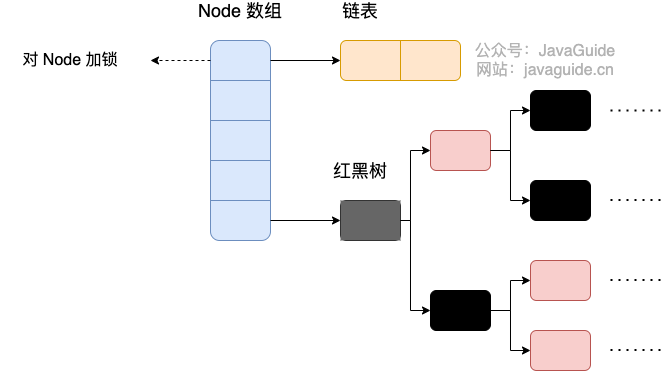ConcurrentHashMap源码分析
特性
ConcurrentHashMap 是线程安全的hashmap
jdk1.8后结构图
Node 数组 + 链表 / 红黑树。当冲突链表达到一定长度时,链表会转换成红黑树
初始化
/**
* Initializes table, using the size recorded in sizeCtl.
*/
private final Node<K,V>[] initTable() {
Node<K,V>[] tab; int sc;
while ((tab = table) == null || tab.length == 0) {
// 如果 sizeCtl < 0 ,说明另外的线程执行CAS 成功,正在进行初始化。
if ((sc = sizeCtl) < 0)
// 让出 CPU 使用权
Thread.yield(); // lost initialization race; just spin
else if (U.compareAndSwapInt(this, SIZECTL, sc, -1)) {
try {
if ((tab = table) == null || tab.length == 0) {
int n = (sc > 0) ? sc : DEFAULT_CAPACITY;
@SuppressWarnings("unchecked")
Node<K,V>[] nt = (Node<K,V>[])new Node<?,?>[n];
table = tab = nt;
sc = n - (n >>> 2);
}
} finally {
sizeCtl = sc;
}
break;
}
}
return tab;
}
从源码中可以发现 ConcurrentHashMap 的初始化是通过自旋和 CAS 操作完成的。里面需要注意的是变量 sizeCtl ,它的值决定着当前的初始化状态。
-1 说明正在初始化
-N 说明有 N-1 个线程正在进行扩容
0 表示 table 初始化大小,如果 table 没有初始化>0 表示
table 扩容的阈值,如果 table 已经初始化
cas指的是比较和交换
自旋指的是当一个线程尝试获取某个锁时,如果该锁已被其他线程占用,就一直循环检测锁是否被释放,而不是进入线程挂起或睡眠状态。
put
public V put(K key, V value) {
return putVal(key, value, false);
}
/** Implementation for put and putIfAbsent */
final V putVal(K key, V value, boolean onlyIfAbsent) {
// key 和 value 不能为空
if (key == null || value == null) throw new NullPointerException();
int hash = spread(key.hashCode());
int binCount = 0;
for (Node<K,V>[] tab = table;;) {
// f = 目标位置元素
Node<K,V> f; int n, i, fh;// fh 后面存放目标位置的元素 hash 值
if (tab == null || (n = tab.length) == 0)
// 数组桶为空,初始化数组桶(自旋+CAS)
tab = initTable();
else if ((f = tabAt(tab, i = (n - 1) & hash)) == null) {
// 桶内为空,CAS 放入,不加锁,成功了就直接 break 跳出
if (casTabAt(tab, i, null,new Node<K,V>(hash, key, value, null)))
break; // no lock when adding to empty bin
}
else if ((fh = f.hash) == MOVED)
tab = helpTransfer(tab, f);
else {
V oldVal = null;
// 使用 synchronized 加锁加入节点
synchronized (f) {
if (tabAt(tab, i) == f) {
// 说明是链表
if (fh >= 0) {
binCount = 1;
// 循环加入新的或者覆盖节点
for (Node<K,V> e = f;; ++binCount) {
K ek;
if (e.hash == hash &&
((ek = e.key) == key ||
(ek != null && key.equals(ek)))) {
oldVal = e.val;
if (!onlyIfAbsent)
e.val = value;
break;
}
Node<K,V> pred = e;
if ((e = e.next) == null) {
pred.next = new Node<K,V>(hash, key,
value, null);
break;
}
}
}
else if (f instanceof TreeBin) {
// 红黑树
Node<K,V> p;
binCount = 2;
if ((p = ((TreeBin<K,V>)f).putTreeVal(hash, key,
value)) != null) {
oldVal = p.val;
if (!onlyIfAbsent)
p.val = value;
}
}
}
}
if (binCount != 0) {
if (binCount >= TREEIFY_THRESHOLD)
treeifyBin(tab, i);
if (oldVal != null)
return oldVal;
break;
}
}
}
addCount(1L, binCount);
return null;
}
- 根据 key 计算出 hashcode 。
- 判断是否需要进行初始化。
- 即为当前 key 定位出的Node,如果为空表示当前位置可以写入数据,利用 CAS 尝试写入,失败则自旋保证成功。
- 如果当前位置的 hashcode == MOVED == -1,则需要进行扩容。
- 如果都不满足,则利用 synchronized 锁写入数据。
- 如果数量大于 TREEIFY_THRESHOLD 则要执行树化方法,在 treeifyBin 中会首先判断当前数组长度 ≥64 时才会将链表转换为红黑树。
get
public V get(Object key) {
Node<K,V>[] tab; Node<K,V> e, p; int n, eh; K ek;
// key 所在的 hash 位置
int h = spread(key.hashCode());
if ((tab = table) != null && (n = tab.length) > 0 &&
(e = tabAt(tab, (n - 1) & h)) != null) {
// 如果指定位置元素存在,头结点hash值相同
if ((eh = e.hash) == h) {
if ((ek = e.key) == key || (ek != null && key.equals(ek)))
// key hash 值相等,key值相同,直接返回元素 value
return e.val;
}
else if (eh < 0)
// 头结点hash值小于0,说明正在扩容或者是红黑树,find查找
return (p = e.find(h, key)) != null ? p.val : null;
while ((e = e.next) != null) {
// 是链表,遍历查找
if (e.hash == h &&
((ek = e.key) == key || (ek != null && key.equals(ek))))
return e.val;
}
}
return null;
}
- 根据 hash 值计算位置。
- 查找到指定位置,如果头节点就是要找的,直接返回它的 value.
- 如果头节点 hash 值小于 0 ,说明正在扩容或者是红黑树,查找之。
- 如果是链表,遍历查找之。
总结
java8 中的 ConcurrentHashMap 使用的 Synchronized 锁加 CAS 的机制。结构也由 Java7 中的 Segment 数组 + HashEntry 数组 + 链表 进化成了 Node 数组 + 链表 / 红黑树,Node 是类似于一个 HashEntry 的结构。它的冲突再达到一定大小时会转化成红黑树,在冲突小于一定数量时又退回链表。Synchronized 锁自从引入锁升级策略后,性能不再是问题。
作者声明
如有问题,欢迎指正!
